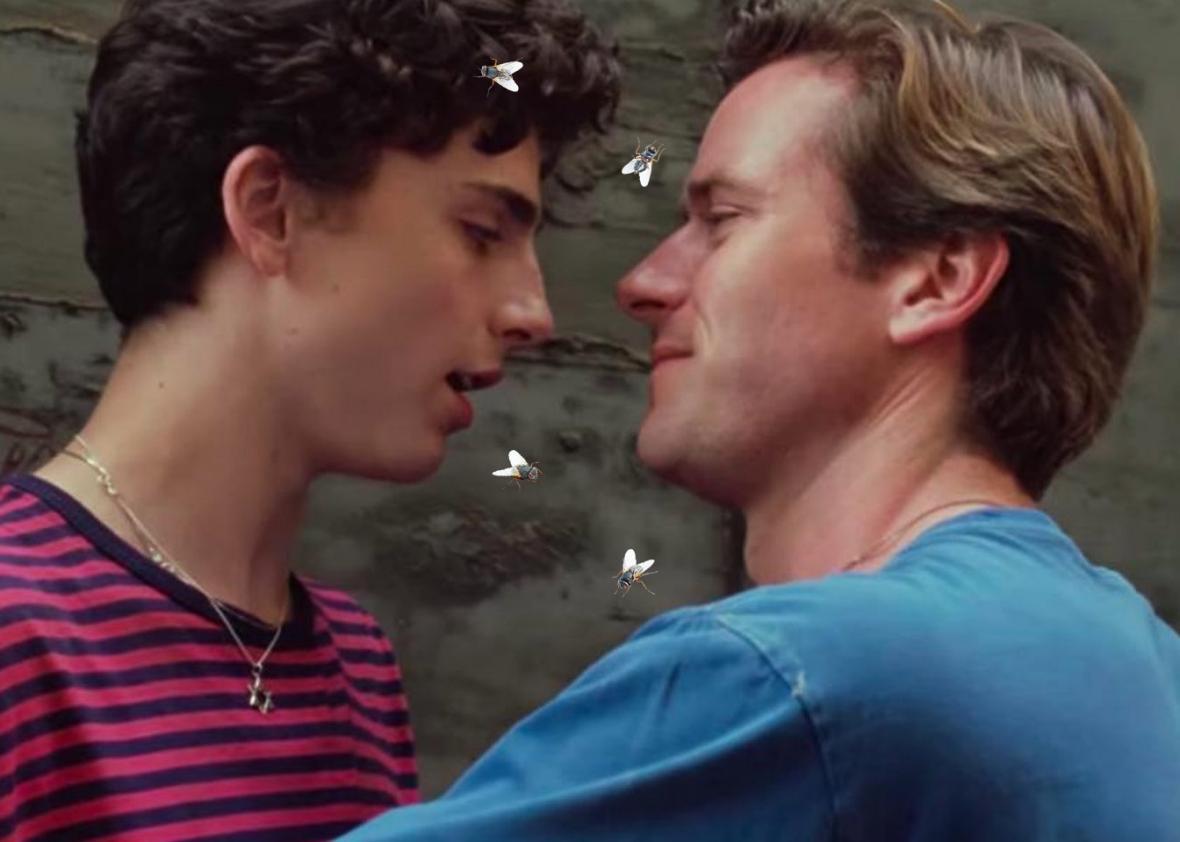Call Me By Your Name, which earlier this month won the Los Angeles Film Critics Circle awards for Best Film, Best Director, and Best Actor, is a lovely if straightforward bildungsromance. Set in northern Italy over the course of a single summer, the movie follows the quiet anguish of Elio (Timothée Chalamet), a 17-year-old kid who realizes he’s fallen in love with his family’s houseguest, the older and much taller Oliver (Armie Hammer). It charts Elio’s emotional development during that fateful season and, ostensibly, the challenges of same-sex attraction and coming to terms with one’s own identity. But as Billy Gray and Miz Cracker both pointed out in earlier Slate articles, this tame adaptation of André Aciman’s 2007 novel hardly engages with queer identity or its associated politics at all. So what is creating Call Me By Your Name’s growing buzz?
Flies. That sound you hear is the housefly, the winged poop-walker, the Musca domestica.
Flies permeate almost every scene of Call Me By Your Name. They dance across the pages on which Elio diligently transcribes his music. They buzz around the breakfast table. And, during the much-lauded final scene of the film, which is one long, tight shot on Elio’s emotional face as he peers into the flames in the dining room fireplace, I found myself distracted, then annoyed, and finally amused by a single fly flitting from Elio’s forehead to his shirt to his hair.
Flies certainly aren’t a motif in Aciman’s novel. The closest mention to a housefly is a quip about Cupid, the tiny airborne god of love: “Find Cupid everywhere in Rome because we’d clipped one of his wings and he was forced to fly in circles” is one of several poetic items on Elio’s to do list. Given flies play no role in the book, it seems clear the housefly had some sort of symbolic meaning or strategic purpose for the film’s director, Luca Guadagnino. But… why?
Perhaps flies are just a result of living with so many fruit trees. The film is constantly emphasizing, with the aid of locally-grown produce, the etymology of the word “apricot” and the sexual potential of peaches. It’s reasonable to assume that the family’s little garden of earthly delights came with some pesky side effects, like flies and maybe bees or other insects, too. And, as Refinery29 also pointed out, the humans don’t seem to help: In one scene, Elio eats a peach, sucks the pit, and then spits it across the room onto the floor. On a hot summer’s day, this is basically asking for buzzing houseguests.
But then again, maybe that’s too literal. How often does trash seem to just disappear, without consequence, in film and on TV? According to the Continuum Encyclopedia of Animal Symbolism in World Art, flies, the “bringers of disease,” symbolize “evil, pestilence, and sin” in Christian painting of the second millennium. This interpretation aligns well with my own personal experiences of flies being absolutely disgusting. Guadagnino, who is Italian and therefore born a scholar of art and history, could certainly have been influenced by art that employed houseflies as dark symbols of destruction. But since no one actually dies in Call Me By Your Name, I’d be inclined to think that Guadagnino is using the notion of “rot” differently here. Flies—and more specifically, maggots—are obviously known for eating flesh, whether it’s that of a peach or a human being. In this way, flies might not be about death so much as carnal desire; the fixation on the flesh, the festering of repressed desires.
One of the most interesting aspects of a fly’s life, at least narratively speaking, is just how short it is. The average housefly lives just 28 days. Their cousins, the mayflies, get just a few minutes. This impermanence has inspired artwork from the Dutch vanitas tradition of the early 17th century to the contemporary podcast The Heart, which produced a mayfly-inspired three-part episode called One Day’s Love. “The mayfly sneaks in through an open window and lives her mayfly life to the fullest—perhaps even finding her true mayfly love,” the short post accompanying the first episode reads. “Before she knows it, death has overtaken her. She lies limply in the windowsill.” I choose to believe that Guadagnino was using these annoying little insects to remind us that no matter how badly the audience or Elio wanted it, his romance with Oliver would always be ephemeral. Because the point of summer is that it ends. And sometimes, the list of summer’s casualties includes you.
Through a press representative, Guadagnino declined to explain why his beautiful movie has flies crawling all over it. And maybe that’s for the best. While the ham-handed symbolism in The Great Gatsby (remember the green light over Daisy’s house? or the breaking of the clock?) works just fine for high school English courses, the best symbols are the ones you can never totally nail down. Like the buzzing of fly, they needle you long after the story is finished.
